Energy Performance of Buildings with Thermochromic Windows in Mediterranean Climates
Abstract
:1. Introduction
1.1. Existing Building Energy Consumption
1.2. Reducing Energy Needs by Passive Measures
1.3. Scope of the Study
2. Methodology
2.1. Mediterranean Cities
- Jaen, Marseille, Thessaloniki, Lisboa, and Izmir share semi-arid climate,
- Cyprus, Palma, Heraklion, Cagliari, and Catania share insular climate,
- Algiers, Alexandria, Beersheva, Tripoli, and Tunis share arid climate.
2.2. Building Case Study
3. Results
3.1. Arid Mediterranean Climates
3.2. Semi-Arid Mediterranean Climates
3.3. Insular Mediterranean Climates
4. Conclusions
Author Contributions
Funding
Institutional Review Board Statement
Informed Consent Statement
Data Availability Statement
Acknowledgments
Conflicts of Interest
References
- Carnieletto, L.; Badenes, B.; Belliardi, M.; Bernardi, A.; Graci, S.; Emmi, G.; Urchueguía, J.F.; Zarrella, A.; Di Bella, A.; Dalla Santa, G.; et al. A European Database of Building Energy Profiles to Support the Design of Ground Source Heat Pumps. Energies 2019, 12, 2496. [Google Scholar] [CrossRef] [Green Version]
- Gil-Baez, M.; Padura, Á.B.; Huelva, M.M. Passive Actions in the Building Envelope to Enhance Sustainability of Schools in a Mediterranean Climate. Energy 2019, 167, 144–158. [Google Scholar] [CrossRef]
- Barbosa, F.C.; de Freitas, V.P.; Almeida, M. School Building Experimental Characterization in Mediterranean Climate Regarding Comfort, Indoor Air Quality and Energy Consumption. Energy Build. 2020, 212, 109782. [Google Scholar] [CrossRef]
- Katsaprakakis, D.A.; Zidianakis, G.; Yiannakoudakis, Y.; Manioudakis, E.; Dakanali, I.; Kanouras, S. Working on Buildings’ Energy Performance Upgrade in Mediterranean Climate. Energies 2020, 13, 2159. [Google Scholar] [CrossRef]
- López-Ochoa, L.M.; Bobadilla-Martínez, D.; Las-Heras-Casas, J.; López-González, L.M. Towards Nearly Zero-Energy Educational Buildings with the Implementation of the Energy Performance of Buildings Directive via Energy Rehabilitation in Cold Mediterranean Zones: The Case of Spain. Energy Rep. 2019, 5, 1488–1508. [Google Scholar] [CrossRef]
- Feijó-Muñoz, J.; Pardal, C.; Echarri, V.; Fernández-Agüera, J.; de Larriva, R.A.; Calderín, M.M.; Poza-Casado, I.; Padilla-Marcos, M.Á.; Meiss, A. Energy Impact of the Air Infiltration in Residential Buildings in the Mediterranean Area of Spain and the Canary Islands. Energy Build. 2019, 188–189, 226–238. [Google Scholar] [CrossRef]
- Gasparella, A.; Pernigotto, G.; Cappelletti, F.; Romagnoni, P.; Baggio, P. Analysis and Modelling of Window and Glazing Systems Energy Performance for a Well Insulated Residential Building. Energy Build. 2011, 43, 1030–1037. [Google Scholar] [CrossRef]
- Su, X.; Zhang, X. Environmental Performance Optimization of Window–Wall Ratio for Different Window Type in Hot Summer and Cold Winter Zone in China Based on Life Cycle Assessment. Energy Build. 2010, 42, 198–202. [Google Scholar] [CrossRef]
- Goia, F. Search for the Optimal Window-to-Wall Ratio in Office Buildings in Different European Climates and the Implications on Total Energy Saving Potential. Sol. Energy 2016, 132, 467–492. [Google Scholar] [CrossRef]
- Alwetaishi, M.; Benjeddou, O. Impact of Window to Wall Ratio on Energy Loads in Hot Regions: A Study of Building Energy Performance. Energies 2021, 14, 1080. [Google Scholar] [CrossRef]
- Webb, A.L. Energy Retrofits in Historic and Traditional Buildings: A Review of Problems and Methods. Renew. Sustain. Energy Rev. 2017, 77, 748–759. [Google Scholar] [CrossRef]
- Knoop, M.; Aktuna, B.; Bueno, B.; Darula, S.; Deneyer, A.; Diakite, A.; Fuhrmann, P.; Geisler-Moroder, D.; Hubschneider, C.; Johnsen, K.; et al. Daylighting and Electric Lighting Retrofit Solutions; Universitätsverlag der TU Berlin: Berlin, Germany, 2016. [Google Scholar]
- Carletti, C.; Cellai, G.; Pierangioli, L.; Sciurpi, F.; Secchi, S. The Influence of Daylighting in Buildings with Parameters NZEB: Application to the Case Study for an Office in Tuscany Mediterranean Area. Energy Procedia 2017, 140, 339–350. [Google Scholar] [CrossRef]
- Maiolo, M.; Pirouz, B.; Bruno, R.; Palermo, S.A.; Arcuri, N.; Piro, P. The Role of the Extensive Green Roofs on Decreasing Building Energy Consumption in the Mediterranean Climate. Sustainability 2020, 12, 359. [Google Scholar] [CrossRef] [Green Version]
- Katsaprakakis, D.A.; Georgila, K.; Zidianakis, G.; Michopoulos, A.; Psarras, N.; Christakis, D.G.; Condaxakis, C.; Kanouras, S. Energy Upgrading of Buildings. A Holistic Approach for the Natural History Museum of Crete, Greece. Renew. Energy 2017, 114, 1306–1332. [Google Scholar] [CrossRef]
- Ziogou, I.; Michopoulos, A.; Voulgari, V.; Zachariadis, T. Implementation of Green Roof Technology in Residential Buildings and Neighborhoods of Cyprus. Sustain. Cities Soc. 2018, 40, 233–243. [Google Scholar] [CrossRef]
- Cascone, S.; Catania, F.; Gagliano, A.; Sciuto, G. A Comprehensive Study on Green Roof Performance for Retrofitting Existing Buildings. Build. Environ. 2018, 136, 227–239. [Google Scholar] [CrossRef]
- Hu, J.; Yu, X.B. Adaptive Thermochromic Roof System: Assessment of Performance under Different Climates. Energy Build. 2019, 192, 1–14. [Google Scholar] [CrossRef]
- Zinzi, M.; Agnoli, S.; Ulpiani, G.; Mattoni, B. On the Potential of Switching Cool Roofs to Optimize the Thermal Response of Residential Buildings in the Mediterranean Region. Energy Build. 2021, 233, 110698. [Google Scholar] [CrossRef]
- Warwick, M.E.A.; Ridley, I.; Binions, R. Variation of Thermochromic Glazing Systems Transition Temperature, Hysteresis Gradient and Width Effect on Energy Efficiency. Buildings 2016, 6, 22. [Google Scholar] [CrossRef] [Green Version]
- Vernardou, D.; Louloudakis, D.; Spanakis, E.; Katsarakis, N.; Koudoumas, E. Thermochromic Amorphous VO2 Coatings Grown by APCVD Using a Single-Precursor. Sol. Energy Mater. Sol. Cells 2014, 128, 36–40. [Google Scholar] [CrossRef]
- Arnaoutakis, G.E.; Richards, B.S. Geometrical Concentration for Enhanced Up-Conversion: A Review of Recent Results in Energy and Biomedical Applications. Opt. Mater. 2018, 83, 47–54. [Google Scholar] [CrossRef]
- Garshasbi, S.; Santamouris, M. Using Advanced Thermochromic Technologies in the Built Environment: Recent Development and Potential to Decrease the Energy Consumption and Fight Urban Overheating. Sol. Energy Mater. Sol. Cells 2019, 191, 21–32. [Google Scholar] [CrossRef]
- Hu, F.; An, L.; Li, C.; Liu, J.; Ma, G.; Hu, Y.; Huang, Y.; Liu, Y.; Thundat, T.; Ren, S. Transparent and Flexible Thermal Insulation Window Material. Cell Rep. Phys. Sci. 2020, 1, 100140. [Google Scholar] [CrossRef]
- An, L.; Petit, D.; Di Luigi, M.; Sheng, A.; Huang, Y.; Hu, Y.; Li, Z.; Ren, S. Reflective Paint Consisting of Mesoporous Silica Aerogel and Titania Nanoparticles for Thermal Management. ACS Appl. Nano Mater. 2021, 4, 6357–6363. [Google Scholar] [CrossRef]
- Teixeira, H.; da Gomes, M.G.; Rodrigues, A.M.; Pereira, J. In-Service Thermal and Luminous Performance Monitoring of a Refurbished Building with Solar Control Films on the Glazing System. Energies 2021, 14, 1388. [Google Scholar] [CrossRef]
- Alwetaishi, M.; Taki, A. Investigation into Energy Performance of a School Building in a Hot Climate: Optimum of Window-to-Wall Ratio. Indoor Built Environ. 2020, 29, 24–39. [Google Scholar] [CrossRef]
- Saroglou, T.; Theodosiou, T.; Givoni, B.; Meir, I.A. A Study of Different Envelope Scenarios towards Low Carbon High-Rise Buildings in the Mediterranean Climate-Can DSF Be Part of the Solution? Renew. Sustain. Energy Rev. 2019, 113, 109237. [Google Scholar] [CrossRef]
- Arnesano, M.; Pandarese, G.; Martarelli, M.; Naspi, F.; Gurunatha, K.L.; Sol, C.; Portnoi, M.; Ramirez, F.V.; Parkin, I.P.; Papakonstantinou, I.; et al. Optimization of the Thermochromic Glazing Design for Curtain Wall Buildings Based on Experimental Measurements and Dynamic Simulation. Sol. Energy 2021, 216, 14–25. [Google Scholar] [CrossRef]
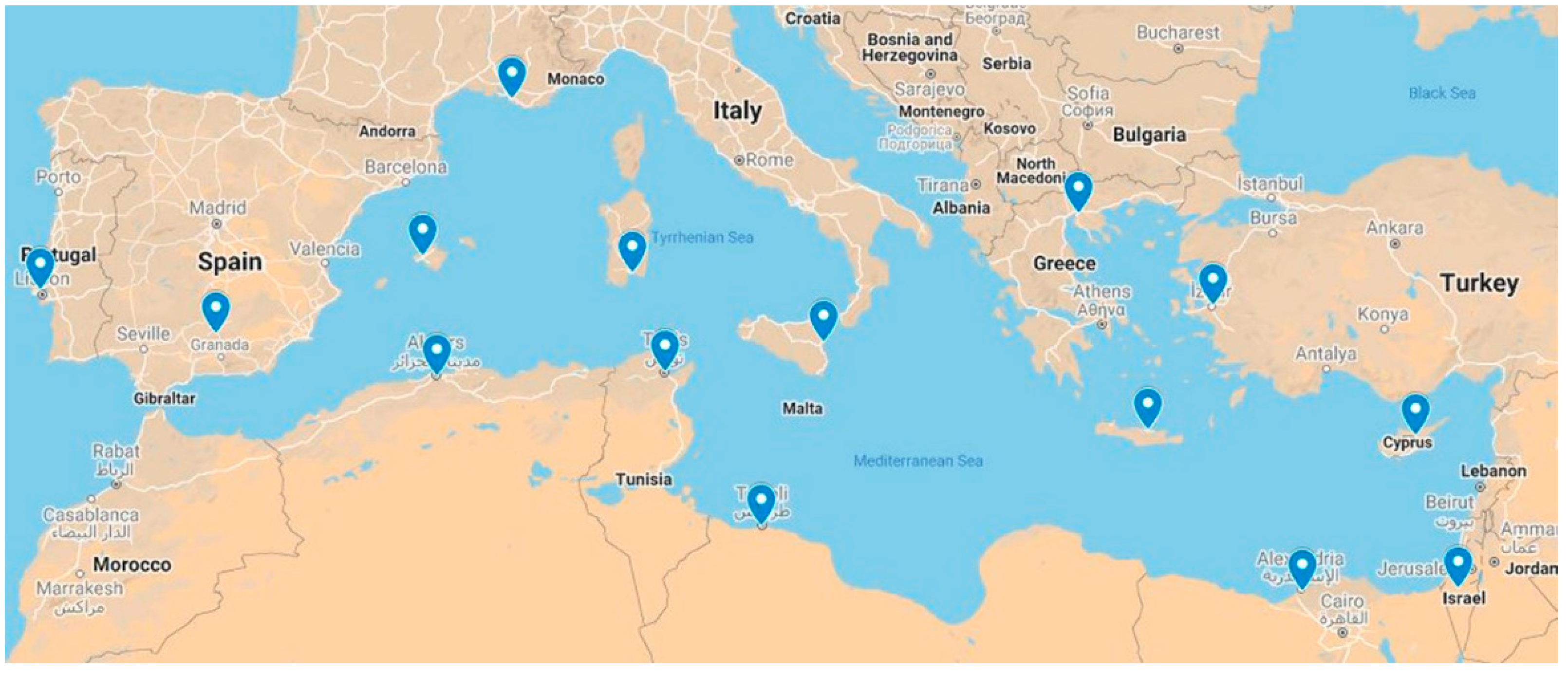


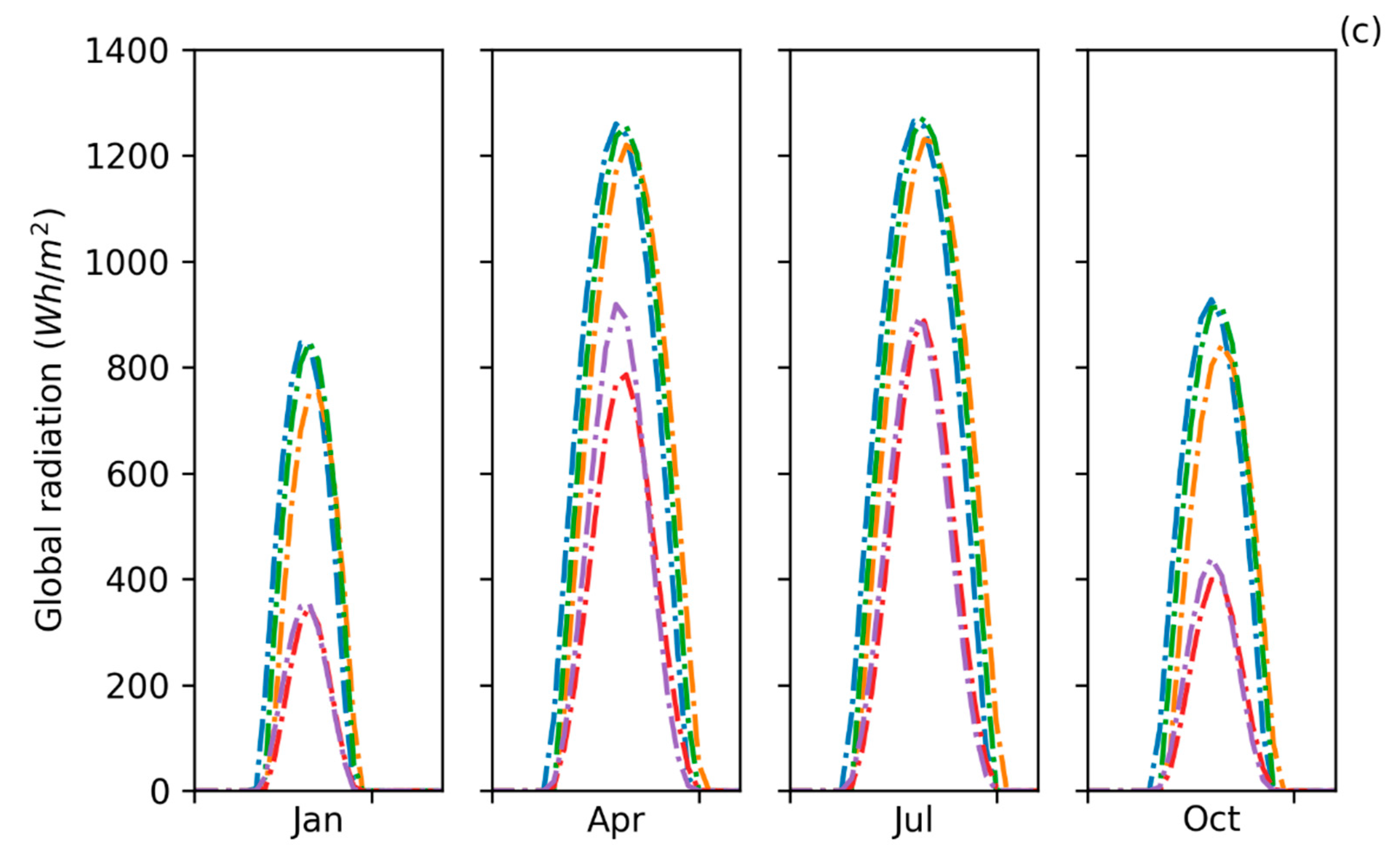
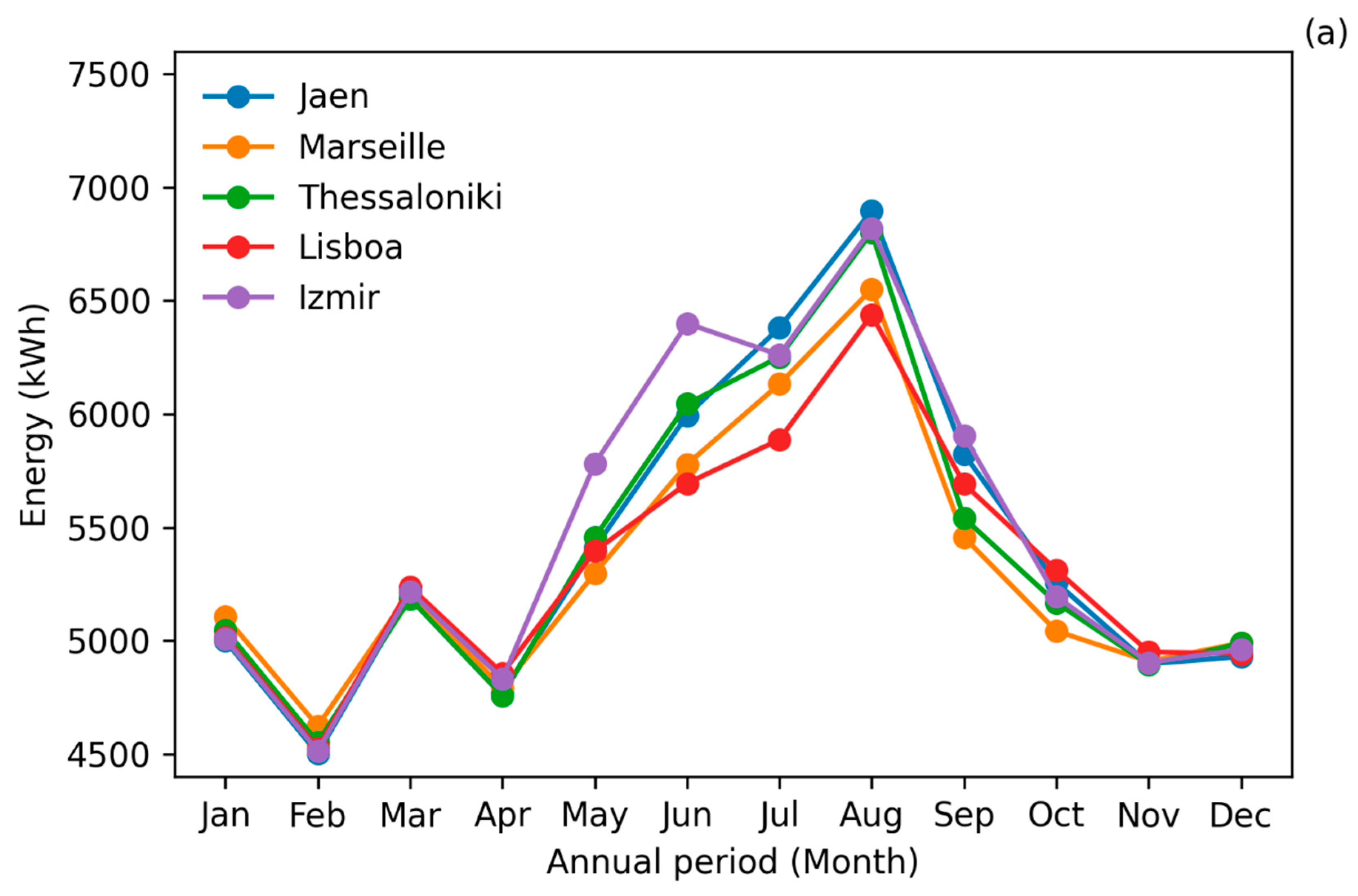
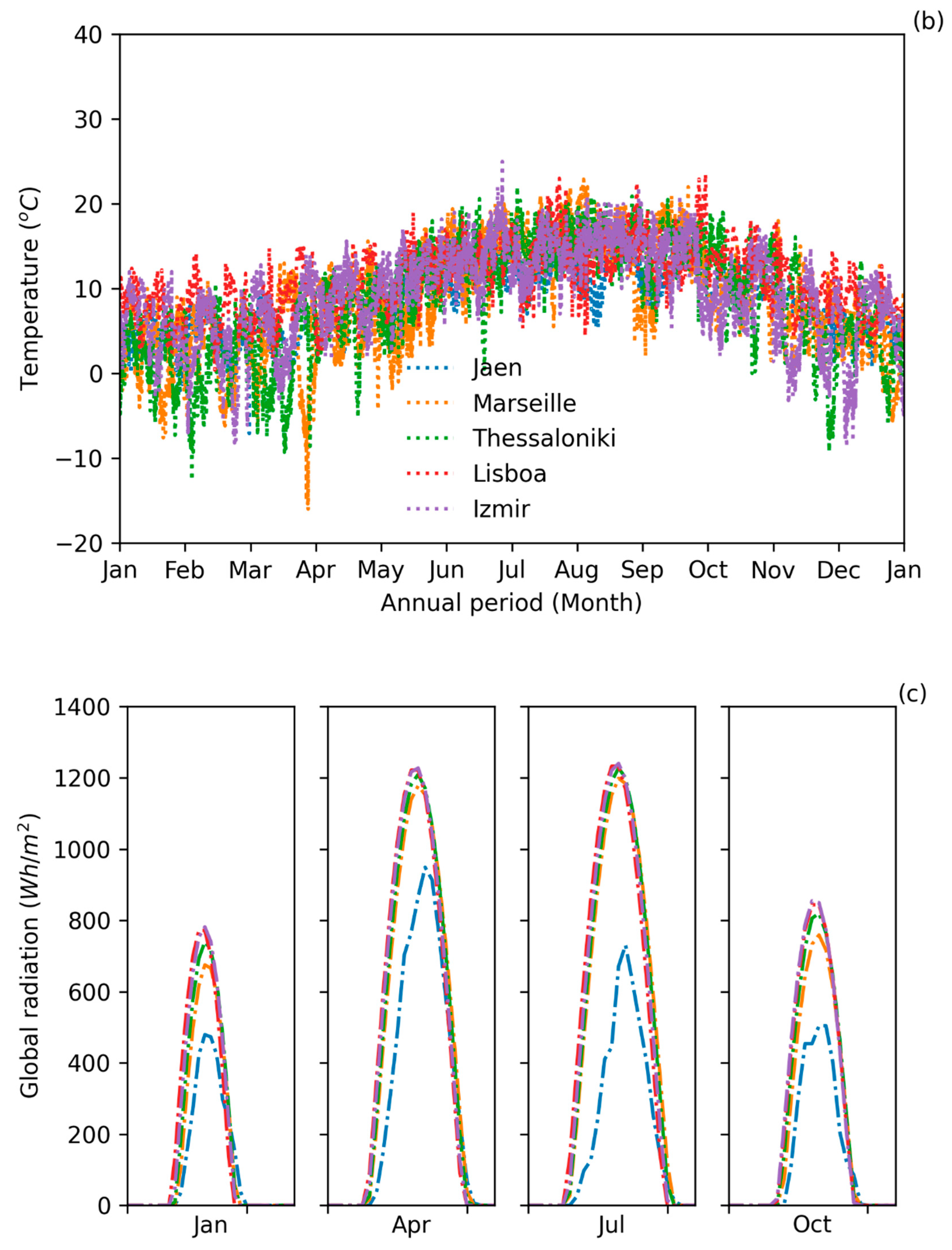
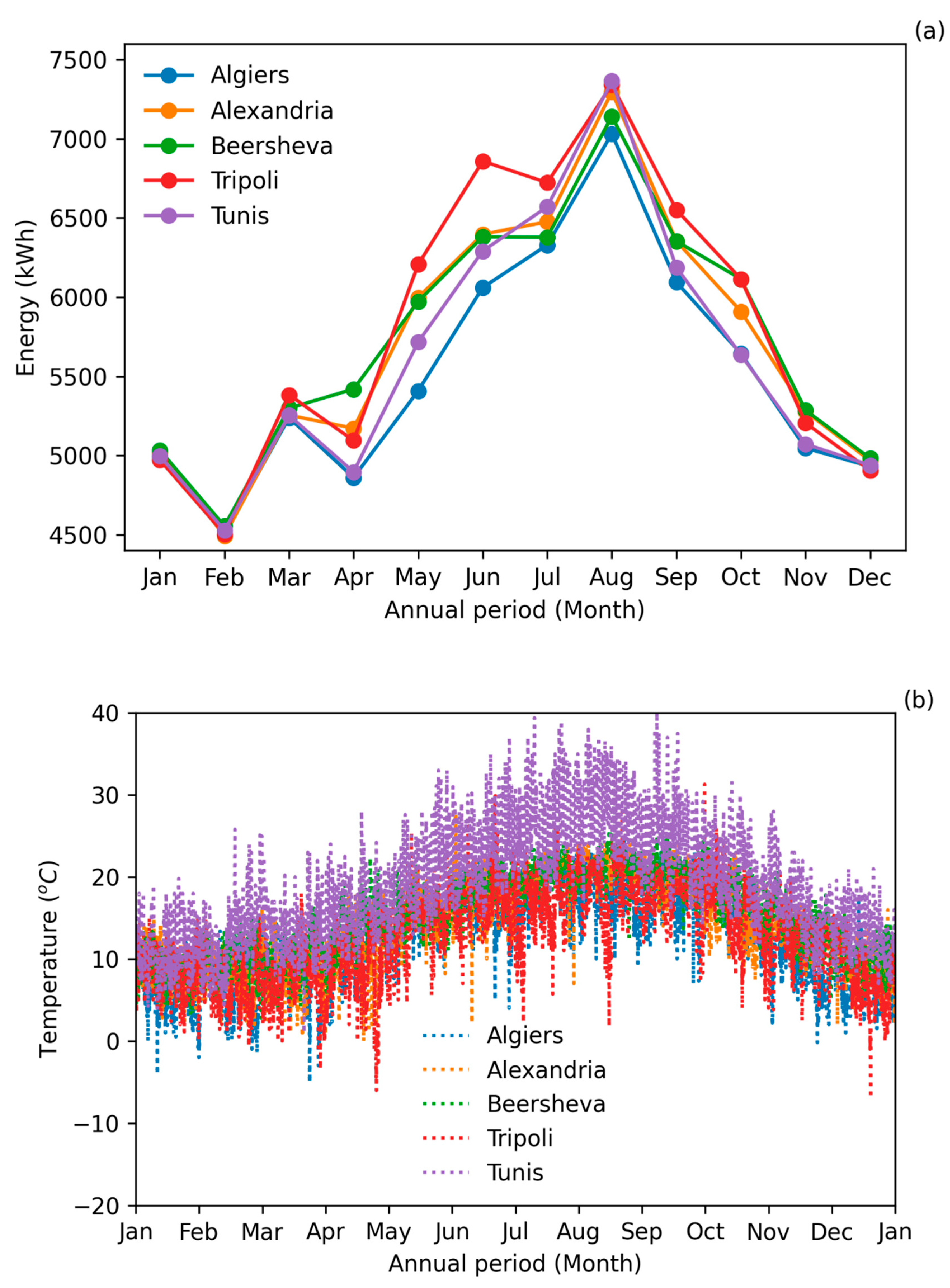
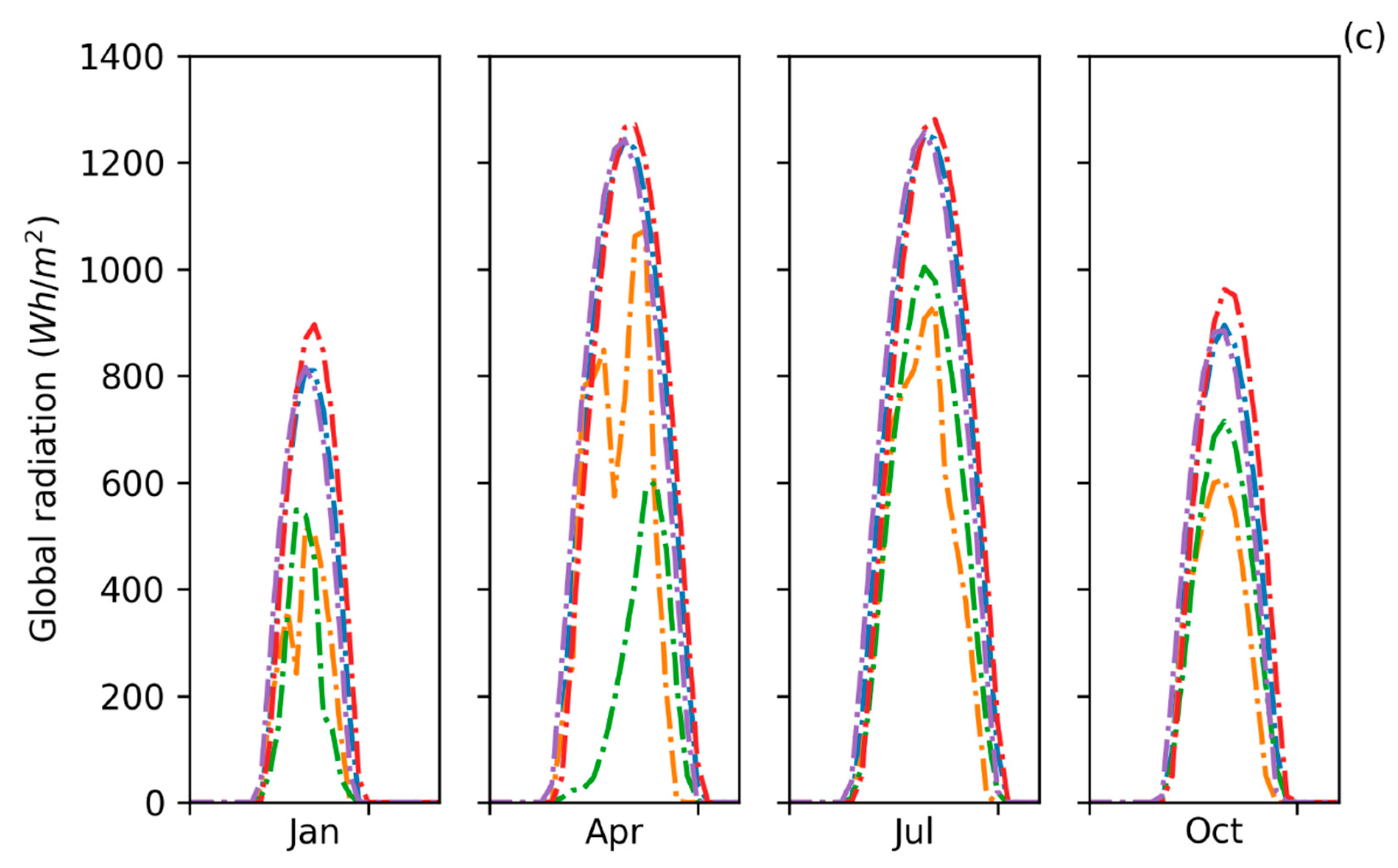
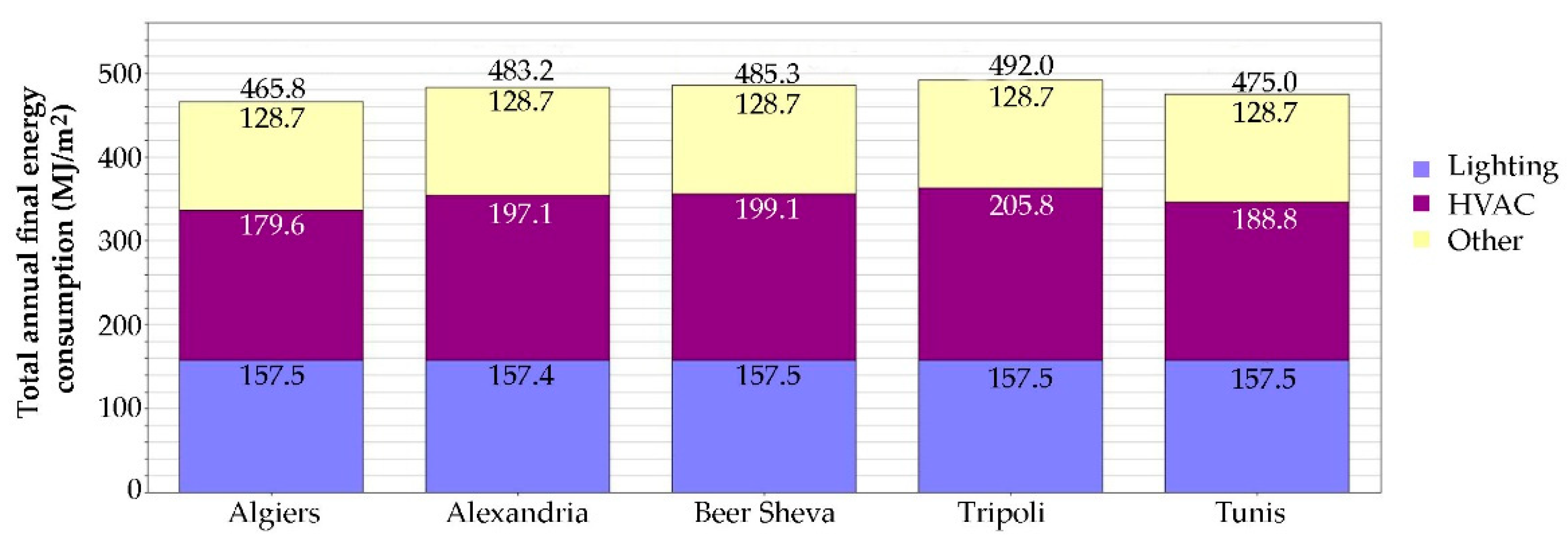





| Material | Thickness (m) | Conductivity (W/m∙K) | Density (kg/m3) | Specific Heat (J/(kg∙K) | Roughness | Thermal Absorptance | Solar Absorptance | Visible Absorptance |
|---|---|---|---|---|---|---|---|---|
| Wood Shingles | 0.0178 | 0.115 | 513 | 1255 | Very Rough | 0.9 | 0.78 | 0.78 |
| Wood Decking | 0.0254 | 0.1211 | 593 | 2510 | Medium Smooth | 0.9 | 0.78 | 0.78 |
| Roof Insulation | 0.2216 | 0.049 | 265 | 836.8 | Medium Rough | 0.9 | 0.7 | 0.7 |
| Gypsum | 0.0127 | 0.16 | 784.9 | 830 | Smooth | 0.9 | 0.92 | 0.92 |
| GP01 1/2 GYPSUM | 0.0127 | 0.16 | 800 | 1090 | Smooth | 0.9 | 0.7 | 0.5 |
| Stucco | 0.0253 | 0.6918 | 1858 | 837 | Smooth | 0.9 | 0.92 | 0.92 |
| Heavyweight Concrete | 0.2033 | 1.7296 | 2243 | 837 | Medium Rough | 0.9 | 0.65 | 0.65 |
| Wall Insulation | 0.0339 | 0.0432 | 91 | 837 | Medium Rough | 0.9 | 0.5 | 0.5 |
| Heavyweight Concrete | 0.1016 | 1.311 | 2240 | 836.8 | Rough | 0.9 | 0.7 | 0.7 |
| Floor Insulation | 0.0464 | 0.045 | 265 | 836.8 | Medium Rough | 0.9 | 0.7 | 0.7 |
| MAT-CC05 8 Heavyweight Concrete | 0.2032 | 1.311 | 2240 | 836.8 | Rough | 0.9 | 0.7 | 0.7 |
| Gypsum Top | 0.0127 | 0.16 | 784.9 | 830 | Smooth | 0.9 | 0.92 | 0.92 |
| Attic Floor Insulation | 0.2379 | 0.049 | 265 | 836.8 | Medium Rough | 0.9 | 0.7 | 0.7 |
| Gypsum Bottom | 0.0127 | 0.16 | 784.9 | 830 | Smooth | 0.9 | 0.92 | 0.92 |
| Roof Membrane | 0.0095 | 0.16 | 1121.3 | 1460 | Very Rough | 0.9 | 0.7 | 0.7 |
| Metal Decking | 0.0015 | 45.006 | 7680 | 418.4 | Medium Smooth | 0.9 | 0.7 | 0.3 |
| METAL Door Medium 18Ga_1 | 0.0013 | 45.3149 | 7833 | 502.08 | Smooth | 0.8 | 0.5 | 0.5 |
| METAL Door Medium 18Ga_2 | 0.0013 | 45.3149 | 7833 | 502.08 | Smooth | 0.8 | 0.5 | 0.5 |
| Std Wood 6inch | 0.15 | 0.12 | 540 | 1210 | Medium Smooth | 0.9 | 0.7 | 0.7 |
| Std 1.5 MW CONCRETE | 0.038 | 0.858 | 1968 | 836.8 | Rough | 0.9 | 0.7 | 0.7 |
| Std AC02 | 0.0127 | 0.0570 | 288 | 1339 | Medium Smooth | 0.9 | 0.7 | 0.2 |
| Std MAT-CC05 4 MW CONCRETE | 0.1 | 0.858 | 1968 | 836.8 | Rough | 0.9 | 0.7 | 0.2 |
| Std Very High Reflectivity Surface | 0.0005 | 237 | 2702 | 903 | Smooth | 0.9 | 0.05 | 0.05 |
| Std PW05 | 1.91E-02 | 0.115 | 545 | 1213 | Medium Smooth | 0.9 | 0.78 | 0.78 |
| Std Steel_Brown_Regular | 1.50E-03 | 44.9696 | 7689 | 418 | Smooth | 0.9 | 0.92 | 0.92 |
| Std Steel_Brown_Cool | 1.50E-03 | 44.9696 | 7689 | 418 | Smooth | 0.9 | 0.73 | 0.73 |
| Plywood3/4_in | 0.0191 | 0.115 | 545 | 1213 | Medium Smooth | 0.9 | 0.7 | 0.78 |
| Magnitude | Glass | Thermochromic Layer | Clear Acrylic Plastic | Diffusing Acrylic Plastic |
|---|---|---|---|---|
| Thickness (m) | 0.003 | 0.0075 | 0.003 | 0.0022 |
| Solar transmittance | 0.2442 | 0.92 | 0.9 | |
| Front solar reflectance | 0.7058 | 0.05 | 0.08 | |
| Rear solar reflectance | 0.7058 | 0.05 | 0.08 | |
| Visible transmittance | 0.3192 | 0.92 | 0.9 | |
| Front visible reflectance | 0.6308 | 0.05 | 0.08 | |
| Rear visible reflectance | 0.6308 | 0.05 | 0.08 | |
| IR Transmittance at 0° | 0 | 0 | 0 | 0 |
| Front IR Emissivity (2π) | 0.9 | 0.84 | 0.9 | 0.9 |
| Rear IR Emissivity (2π) | 0.9 | 0.84 | 0.9 | 0.9 |
| Conductivity (W/(m∙K)) | 0.0199 | 0.6 | 0.9 | 0.9 |
| City | Heating, Gas (W) | Unmet Comfort (h) |
|---|---|---|
| Algiers | 24,854 | 1460 |
| Alexandria | 20,638 | 1085 |
| Be’er Sheva | 23,416 | 953 |
| Tripoli | 23,326 | 942 |
| Tunis | 24,067 | 1079 |
| City | Heating, Gas (W) | Unmet Comfort (h) |
|---|---|---|
| Jaen | 26,175 | 1185 |
| Marseille | 26,367 | 1930 |
| Thessaloniki | 26,320 | 1798 |
| Lisboa | 24,581 | 950 |
| Izmir | 25,331 | 1300 |
| City | Heating, Gas (W) | Unmet Comfort (h) |
|---|---|---|
| Larnaca | 25,488 | 1206 |
| Palma | 26,342 | 2067 |
| Heraklion | 25,055 | 928 |
| Cagliari | 26,437 | 1407 |
| Catania | 26,411 | 1379 |
Publisher’s Note: MDPI stays neutral with regard to jurisdictional claims in published maps and institutional affiliations. |
© 2021 by the authors. Licensee MDPI, Basel, Switzerland. This article is an open access article distributed under the terms and conditions of the Creative Commons Attribution (CC BY) license (https://creativecommons.org/licenses/by/4.0/).
Share and Cite
Arnaoutakis, G.E.; Katsaprakakis, D.A. Energy Performance of Buildings with Thermochromic Windows in Mediterranean Climates. Energies 2021, 14, 6977. https://doi.org/10.3390/en14216977
Arnaoutakis GE, Katsaprakakis DA. Energy Performance of Buildings with Thermochromic Windows in Mediterranean Climates. Energies. 2021; 14(21):6977. https://doi.org/10.3390/en14216977
Chicago/Turabian StyleArnaoutakis, Georgios E., and Dimitris A. Katsaprakakis. 2021. "Energy Performance of Buildings with Thermochromic Windows in Mediterranean Climates" Energies 14, no. 21: 6977. https://doi.org/10.3390/en14216977
APA StyleArnaoutakis, G. E., & Katsaprakakis, D. A. (2021). Energy Performance of Buildings with Thermochromic Windows in Mediterranean Climates. Energies, 14(21), 6977. https://doi.org/10.3390/en14216977







